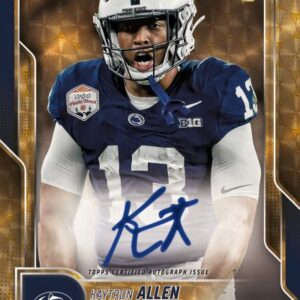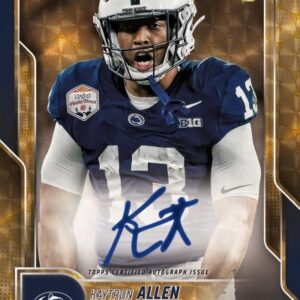Investing in vintage football cards has emerged as a captivating pursuit for sports enthusiasts and collectors. These cards not only hold the essence of football’s greatest moments and players but also offer significant potential for financial growth. Let’s explore the top 10 vintage football cards that are prime candidates for investment, each encapsulating a unique story and a piece of football heritage.
1. 1957 Topps Johnny Unitas Rookie Card (#138):
The rookie card of Johnny Unitas, one of the NFL’s most iconic quarterbacks, leads the list. His 1957 Topps card is highly sought after for its historical significance and investment potential.
2. 1935 National Chicle Bronko Nagurski (#34):
As one of the earliest football cards, the Bronko Nagurski card from the 1935 National Chicle set is a rare find. Nagurski’s status as a football legend makes this card a prized possession.
3. 1965 Topps Joe Namath Rookie Card (#122):
“Broadway Joe” Namath’s rookie card represents the AFL and the rise of modern football. Namath’s charismatic personality and his famous Super Bowl III guarantee add to the card’s allure.
4. 1958 Topps Jim Brown Rookie Card (#62):
Jim Brown, considered one of the greatest football players ever, has a rookie card valued for its rarity and representation of a player who redefined the running back position.
5. 1981 Topps Joe Montana Rookie Card (#216):
Joe Montana, known for his cool demeanor and clutch performances, possesses a highly coveted rookie card from the 1981 Topps set. It’s a must-have for collectors, given Montana’s status in NFL history.
6. 1976 Topps Walter Payton Rookie Card (#148):
Walter Payton, known as “Sweetness,” is remembered for his grace both on and off the field. His rookie card is a fan-favorite among collectors and continues to rise in value.
7. 1984 Topps John Elway Rookie Card (#63):
John Elway’s rookie card captures the beginning of a career that saw him become one of the NFL’s most successful quarterbacks. His two Super Bowl victories in the twilight of his career significantly bolster the card’s value.
8. 1986 Topps Jerry Rice Rookie Card (#161):
As the NFL’s all-time leader in most major statistical categories for wide receivers, Jerry Rice’s rookie card is a valuable asset reflecting his unparalleled career.
9. 1962 Topps Ernie Davis Rookie Card (#36):
Ernie Davis, the first African-American to win the Heisman Trophy, has a rookie card that is both rare and historically significant, making it a meaningful investment.
10. 1951 Bowman Tom Landry Rookie Card (#20):
Before becoming one of the most successful coaches in NFL history, Tom Landry was a player, and his 1951 Bowman rookie card is as iconic as his legacy in the sport.
When considering investments in vintage football cards, several factors must be taken into account to accurately gauge their value. The card’s condition is paramount, with well-preserved cards fetching higher prices. The rarity of the card, its historical importance, and the player’s legacy in the sport also play critical roles in determining its investment potential.
Staying informed about current trends in the sports memorabilia market is essential. Keeping an eye on auction results, participating in collector forums, and reading market analyses provide vital insights into the value and demand for these cards. Networking with other collectors and experts can also yield beneficial information for making informed investment decisions.
In summary, investing in vintage football cards combines sports passion with financial opportunity. The cards mentioned above represent some of the most legendary figures and moments in football history. Their scarcity, condition, and the stories they tell contribute to their mystique and appeal as investment pieces. However, like any investment, success in the vintage football card market requires careful research, a deep understanding of the sport’s history, and an awareness of market dynamics. So, before you dive into the world of vintage football cards, make sure to do your homework and have a game plan.






